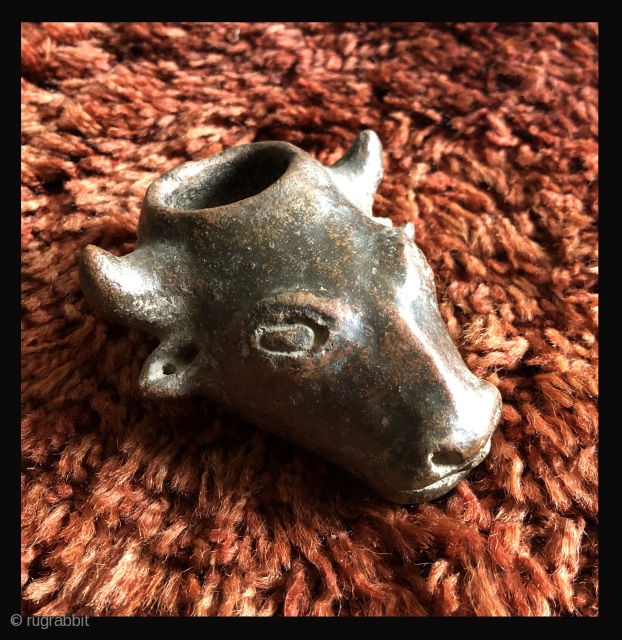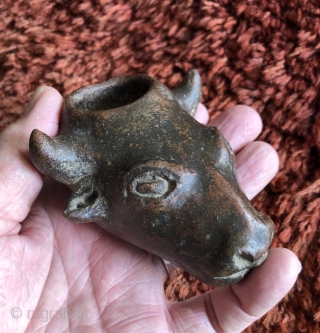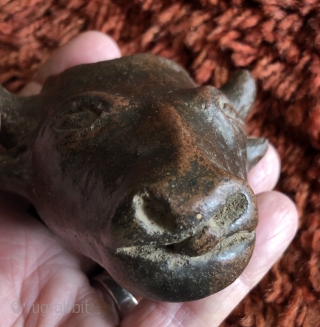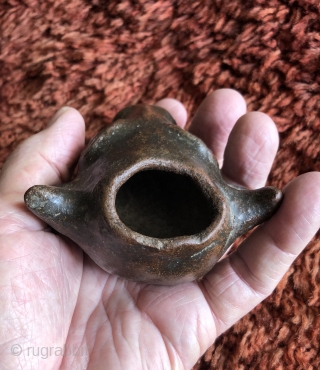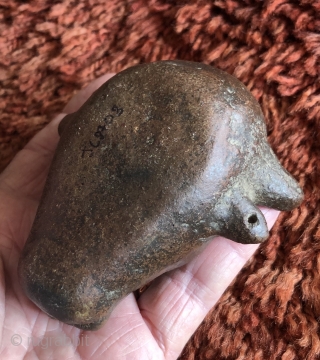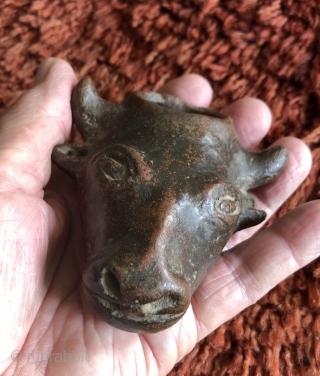Back
This unusual small cow head shaped ceramic is probably a variant type of libation vessel associated with the Animal Increase Rite. i have not seen anything quite like it before. It is made from a hard, dense clay with flecks of pyrite throughout. It once had earrings in its ears as evidenced by the ear holes it retains. One ear is chipped. a subtle but endearing detail seen in this piece is the protruding tongue that is just peaking out of the mouth - in a very bovine-like manner. The ceramic measures 4 x 4 x 2 inches and fits very nicely in the hand. It must have been made to drink a ceremonial liquid of some type, but for just one individual rather than being passed around as is thought typical for the larger vessels. Alternatively, it could be a type of ceremonial vessel meant to contain a mixture of animal fat, coca leaf and other ritual substances. The name for this kind of vessel would be canopa. Canopas predate the conquest and were well represented during the Incan period. There are some post-conquest era canopas made from alabaster, but these are quite rare. This little work of ceramic folk art is a charming, original altiplano ceramic with real ritual importance. It probably dates from the 19th century or before in the late colonial period, but is not from the pre-Columbian era as cows were not known in the Andes until after the arrival of the Spanish..
price:
Inquire
- Home
- Antique Rugs by Region
- Category
- Profiles
- Post Items Free
- Albums
- Benaki Museum of Islamic Art
- Budapest: Ottoman Carpets
- Gulbenkian Museum
- Islamic Carpets. Brooklyn
- Islamic Textiles. Brooklyn
- Konya Museum: Rugs
- MKG, Hamburg
- MMA: Caucasian Carpets
- MMA: Mamluk Carpets
- MMA: Mughal Indian Carpets
- MMA: Ottoman Carpets
- MMA: Safavid Persian Carpets
- MMA: Turkmen Rugs
- McCoy Jones Kilims
- Ottoman textiles. Met
- Philadelphia Museum
- Rugs and Carpets: Berlin
- Seljuqs at the Met
- TIEM, Istanbul: Carpets
- V&A: Classical Carpets
- Vakiflar Carpets: Istanbul
- Baluch Rugs: Indianapolis
- Gallery Exhibitions
- Jaf an Exhibition
- Alberto Levi Gallery
- Andean Textile
- Christie's London: 2016
- Francesca Galloway
- HALI at 40
- ICOC Washington, DC 2018
- Jajims of the Shahsavan
- London Islamic Week April, 2018
- Mongolian Felts
- Navajo Rugs: JB Moore
- Persian Piled Weavings
- SF Tribal & Textile Art Show 2020
- SF Tribal 2019
- Sotheby's: C. Alexander
- Turkish Prayer Rugs
- Turkmen Main Carpets ICOC 2007








